线性回归
为了学习LinearRegression并且用python实现基本功能,我们引入电网系统的例子。文章末尾获取数据包和源代码!
某城市的电网系统需要升级,以应对日益增长的用电需求。电网系统需要考虑最高温度对城市的峰值用电量的影响。项目负责人需要预测明天城市的峰值用电量,他搜集了以往的数据。现在,负责人提供了他搜集到的数据,并请求你帮他训练出一个模型,这个模型能够很好地预测明天城市的峰值用电量。
1 准备
先导入必要的python包
import numpy as np
import matplotlib.pyplot as plt
import time
%matplotlib inline
导入负责人提供的数据,并可视化数据。
data = np.loadtxt('data.txt')
#data 第一列为温度信息 第二列为人口信息
X_raw = data[:,0].reshape(-1,1)
#data 第三列为用电量信息
Y = data[:,2].reshape(-1,1)
plt.xlabel('High temperature')
plt.ylabel('Peak demand ')
plt.scatter(X_raw,Y)
print('X shape:',X_raw.shape)
print('Y shape:',Y.shape)
print('some X[:5]:\n',X_raw[:5])
print('some Y[:5]:\n',Y[:5])
运行结果:
X shape: (80, 1)
Y shape: (80, 1)
some X[:5]:
[[38.24]
[36.53]
[32.92]
[26.59]
[20.05]]
some Y[:5]:
[[4.04]
[2.84]
[3.2 ]
[3.42]
[2.32]]
根据对数据可视化结果的分析,决定使用回归算法训练一个模型,用来预测明天城市的峰值用电量。首先考虑单变量的线性回归模型。
2 单变量线性回归理论介绍
2.1 单变量线性回归模型
单变量线性回归的模型由两个参数 θ 0 \theta_0 θ0, θ 1 \theta_1 θ1来表示一条直线:
P e a k d e m a n d ≈ θ 0 + θ 1 ⋅ ( H i g h t e m p e r a t u r e ) 。 Peak\ demand \approx \theta_0 + \theta_1 \cdot (High\ temperature) 。 Peak demand≈θ0+θ1⋅(High temperature)。
我们的目标也就是找到一条"最符合"的直线,确定这条直线的参数 θ i \theta_i θi。

设输入的特征——最高温度(F)为
x
(
i
)
∈
R
n
+
1
x^{(i)} \in \mathbb{R}^{n+1}
x(i)∈Rn+1,
i
=
1
,
⋯
,
m
i=1,\cdots,m
i=1,⋯,m。
m
m
m为样本总数,在该例子中
m
m
m=80。
n
n
n为特征的个数,这里为
1
1
1。
则:
x
(
i
)
∈
R
2
=
[
1
high temperature for day
i
]
。
x^{(i)} \in \mathbb{R}^2 = \begin{bmatrix} 1 \\ \text{high temperature for day} i\end{bmatrix}。
x(i)∈R2=[1high temperature for dayi]。
设输出为 y ( i ) ∈ R y^{(i)} \in \mathbb{R} y(i)∈R,表示第 i i i天的峰值用电量。
参数为 θ ∈ R n + 1 = [ θ 0 θ 1 ⋮ θ n ] \theta \in \mathbb{R}^{n+1} = \begin{bmatrix} \theta_0 \\ \theta_1 \\ \vdots \\ \theta_n \end{bmatrix} θ∈Rn+1= θ0θ1⋮θn 。这里 n = 1 n=1 n=1。
在该例子中,模型为一条直线,模型可表示为:
h
θ
(
x
)
=
θ
T
x
=
θ
0
+
θ
1
x
。
h_{\theta}(x) = \theta^T x = \theta_0 + \theta_1 x 。
hθ(x)=θTx=θ0+θ1x。
注意:
这里的
θ
T
\theta^T
θT是一个向量,
θ
0
,
θ
1
\theta_0,\theta_1
θ0,θ1是标量。使用向量化表示的原因为:(1)简化数学公式的书写(2)与程序代码中的表示保持一致,且使用向量化的代码实现可以加速运算,因此一般能不用for循环的地方都不用for循环。
下面用一个简单的例子说明向量化的代码运算更快。
# 随机初始化两个向量,计算它们的点积
x = np.random.rand(10000000,1)
y = np.random.rand(10000000,1)
ans = 0
start = time.time()
for i in range(10000000):
ans += x[i,0]*y[i,0]
end = time.time()
print('for循环的计算时间: %.2fs'%(end - start))
print('计算结果:%.2f'%(ans))
start = time.time()
ans = np.dot(x.T,y)
end = time.time()
print('向量化的计算时间: %.2fs'%(end - start))
print('计算结果:%.2f'%(ans))
运行结果:
for循环的计算时间: 7.46s
计算结果:2500872.47
向量化的计算时间: 0.00s
计算结果:2500872.47
因为
θ
0
+
θ
1
x
=
[
1
x
]
[
θ
0
θ
1
]
。
\theta_0 + \theta_1 x=\begin{bmatrix} 1 \quad x \end{bmatrix} \begin{bmatrix} \theta_0 \\ \theta_1 \end{bmatrix} 。
θ0+θ1x=[1x][θ0θ1]。
因此,为了方便编程,我们需要给每一个
x
(
i
)
x^{(i)}
x(i)的前面再加一列1。使得每一个
x
(
i
)
x^{(i)}
x(i)成为一个2维向量。
2.2 预测结果
模型需要根据输入自变量 x ( i ) x^{(i)} x(i) 和参数 θ \theta θ 来输出预测结果 p r e d i c t _ y ( i ) predict\_y^{(i)} predict_y(i)。
将自变量 x ( i ) x^{(i)} x(i) 作为模型的输入,模型根据输入和当前参数 θ \theta θ 输出预测结果:
p r e d i c t _ y ( i ) = h θ ( x ( i ) ) 。 predict\_y^{(i)} = h_\theta(x^{(i)})。 predict_y(i)=hθ(x(i))。
其中 h θ ( ) h_\theta() hθ() 为模型在参数为 θ \theta θ 情况下,对于输入的预测函数。
在预测阶段, x x x作为自变量。
2.3 损失函数
模型的预测结果和实际结果有差距,为了衡量它们之间的差距,或者说量化使用这个模型产生的损失,我们定义损失函数
l
(
p
r
e
d
i
c
t
_
y
(
i
)
,
y
(
i
)
)
l(predict\_y^{(i)}, y^{(i)})
l(predict_y(i),y(i))。这里我们使用平方损失:
l
(
p
r
e
d
i
c
t
_
y
,
y
)
=
(
p
r
e
d
i
c
t
_
y
(
i
)
−
y
(
i
)
)
2
。
l(predict\_y, y) = \left ( predict\_y^{(i)} - y^{(i)} \right )^2。
l(predict_y,y)=(predict_y(i)−y(i))2。
上述损失函数表示一个样本的损失,整个训练集的损失使用
J
(
θ
)
J(\theta)
J(θ)表示:
J
(
θ
)
=
1
2
m
∑
i
=
1
m
l
(
p
r
e
d
i
c
t
_
y
(
i
)
,
y
(
i
)
)
=
1
2
m
∑
i
=
1
m
(
h
θ
(
x
(
i
)
)
−
y
(
i
)
)
2
=
1
2
m
∑
i
=
1
m
(
θ
T
x
(
i
)
−
y
(
i
)
)
2
。
\begin{aligned} J(\theta) & = \frac{1}{2m} \sum_{i=1}^{m}l(predict\_y^{(i)}, y^{(i)}) \\ & = \frac{1}{2m} \sum_{i=1}^{m} \left ( h_\theta(x^{(i)}) - y^{(i)} \right )^2 \\ & = \frac{1}{2m} \sum_{i=1}^{m} \left ( \theta^T x^{(i)} - y^{(i)} \right )^2。 \end{aligned}
J(θ)=2m1i=1∑ml(predict_y(i),y(i))=2m1i=1∑m(hθ(x(i))−y(i))2=2m1i=1∑m(θTx(i)−y(i))2。
(其中数字2的作用是方便求导时的运算)
为了使模型取得较好的预测效果,需要最小化训练集上的损失,即 min θ J ( θ ) \underset{\theta}{\min} J(\theta) θminJ(θ)。
在损失阶段, θ \theta θ 作为自变量。
2.4 梯度下降法
为了得到使损失函数 J ( θ ) J(\theta) J(θ)最小化的 θ \theta θ,可以使用梯度下降法。
损失函数 J ( θ ) J(\theta) J(θ)的函数图像如下:

损失函数
J
(
θ
)
J(\theta)
J(θ)关于参数向量
θ
\theta
θ中的一个参数,比如
θ
1
\theta_1
θ1的函数图为:

假设一开始 J ( θ ) J(\theta) J(θ)的值在紫色点上,为了降低 J ( θ ) J(\theta) J(θ)值,需要 θ 1 \theta_1 θ1往右边移动,这个方向是 J ( θ ) J(\theta) J(θ)在 θ 1 \theta_1 θ1上的负梯度。只要 θ \theta θ不断往负梯度方向移动, J ( θ ) J(\theta) J(θ)一定可以降到最低值。梯度下降法就是使参数 θ \theta θ不断往负梯度移动,经过有限次迭代(更新 θ \theta θ值)之后,损失函数 J ( θ ) J(\theta) J(θ)达到最低值。
梯度下降法的过程:
- 初始化参数向量 θ \theta θ。
- 开始迭代
A.根据实际输入 x x x和参数 θ \theta θ预测输出,
B. 根据预测输出值和实际输出值之间的差距,计算损失函数 J ( θ ) J(\theta) J(θ),
C. 计算损失函数对 θ \theta θ的梯度,
D. 更新参数 θ \theta θ。
3 实现单变量线性回归算法
以上是LinearRegression的理论介绍,接下来我们实现具体的Python代码。
3.1 数据预处理
在
X
X
X前面加上一列1,表示参数
θ
0
\theta_0
θ0的系数,方便运算。
假设
X
X
X是形状为
(
m
,
1
)
(m,1)
(m,1)的矩阵,一共
m
m
m行数据,我们需要为每一行数据的前面加一列1,如下所示:
[
x
(
0
)
x
(
1
)
⋮
x
(
m
−
1
)
]
⟶
[
1
x
(
0
)
1
x
(
1
)
⋮
1
x
(
m
−
1
)
]
。
\begin{bmatrix} x^{(0)} \\ x^{(1)} \\ \vdots \\x^{(m-1)} \end{bmatrix} \longrightarrow \begin{bmatrix} 1\quad x^{(0)} \\ 1\quad x^{(1)} \\ \vdots \\ 1\ x^{(m-1)} \end{bmatrix}。
x(0)x(1)⋮x(m−1)
⟶
1x(0)1x(1)⋮1 x(m−1)
。
会用到的函数:
①np.hstack把两个矩阵水平合在一起。
②np.ones用1初始化向量或矩阵。
具体实现代码如下:
def preprocess_data(X):
"""输入预处理 在X前面加一列1
参数:
X:原始数据,shape为(m,1)
返回:
X_train: 在X加一列1的数据,shape为(m,2)
"""
m = X.shape[0] # m 是数据X的行数
X_plus = np.ones((m,1))
X_train = np.hstack((X_plus, X))
return X_train
X = preprocess_data(X_raw)
print('new X shape:',X.shape)
print('Y shape:',Y.shape)
print('new X[:5,:]=\n',X[:5,:])
print('Y[:5,:]=\n',Y[:5,:])
运行结果:
new X shape: (80, 2)
Y shape: (80, 1)
new X[:5,:]=
[[ 1. 38.24]
[ 1. 36.53]
[ 1. 32.92]
[ 1. 26.59]
[ 1. 20.05]]
Y[:5,:]=
[[4.04]
[2.84]
[3.2 ]
[3.42]
[2.32]]
3.2 初始化参数向量
接着,初始化参数向量
θ
\theta
θ。
θ
\theta
θ的shape是
(
2
,
1
)
(2,1)
(2,1),我们随机初始化
θ
\theta
θ。
具体实现代码如下:
def init_parameter(shape):
"""初始化参数
参数:
shape: 参数形状
返回:
theta_init: 初始化后的参数
"""
np.random.seed(0)
m, n = shape
theta_init = np.random.rand(m, n)
return theta_init
theta = init_parameter((2,1))
print('theta shape is ',theta.shape)
print('theta = ',theta)
运行结果:
theta shape is (2, 1)
theta = [[0.5488135 ]
[0.71518937]]
3.3 计算预测值
通过已知
X
X
X 和参数
θ
\theta
θ 计算预测的
p
r
e
d
i
c
t
_
Y
predict\_Y
predict_Y 值。
由于使用for循环单独计算每个预测值效率不高,因此我们需要用向量化的方法代替for循环。
X
X
X 大小为
m
×
(
n
+
1
)
m \times (n+1)
m×(n+1)(
n
n
n表示特征数量,这里
n
=
1
n=1
n=1),每行是一条样本特征向量,
θ
\theta
θ 大小为
(
n
+
1
)
×
1
(n+1) \times 1
(n+1)×1,可以使用
X
θ
X \theta
Xθ(矩阵相乘)计算所有样本的预测结果,大小为
m
×
1
m\times 1
m×1。于是这里的线性模型就可以表示为:
h
θ
(
X
)
=
X
θ
。
h_{\theta}(X) = X \theta。
hθ(X)=Xθ。
这里
h
θ
(
X
)
h_{\theta}(X)
hθ(X)的大小为
m
×
1
m \times 1
m×1,结果上等于
p
r
e
d
i
c
t
_
Y
θ
predict\_Y_\theta
predict_Yθ。
具体实现代码如下:
def compute_predict_Y(X,theta):
"""计算预测结果
参数:
X: 训练集数据特征,shape: (m, 2)
theta: 参数,shape: (2, 1)
返回:
predict_Y: 预测结果,shape: (m,1)
"""
predict_Y = np.dot(X, theta)
return predict_Y
predict_Y = compute_predict_Y(X,theta)
print(predict_Y[:5])
运行结果:
[[27.89765487]
[26.67468106]
[24.09284744]
[19.56569876]
[14.8883603 ]]
3.4 计算损失函数
从公式
J
(
θ
)
=
1
2
m
∑
i
=
1
m
(
p
r
e
d
i
c
t
_
y
θ
(
i
)
−
y
θ
(
i
)
)
2
\begin{aligned} J(\theta) = \frac{1}{2m} \sum_{i=1}^{m} \left ( predict\_y_\theta^{(i)} - y_\theta^{(i)} \right )^2 \end{aligned}
J(θ)=2m1i=1∑m(predict_yθ(i)−yθ(i))2
可以看到有个求和,由于使用for循环效率不高,因此需要用向量化的方法代替for循环。
(
p
r
e
d
i
c
t
_
Y
−
Y
)
2
(predict\_Y - Y)^2
(predict_Y−Y)2计算所有样本的损失值,最后求和并除以
2
m
2m
2m得到
J
(
θ
)
J(\theta)
J(θ)的值,得到的
J
(
θ
)
J(\theta)
J(θ)是一个标量。
会用到的函数:
①np.dot实现矩阵乘法
②np.power(data, 2)实现平方运算
③np.sum实现求和运算
具体的实现代码如下:
def compute_J(predict_Y, Y):
"""计算损失的函数J
参数:
predict_Y: 预测结果,shape: (m, 1)
Y: 训练集数据标签,shape: (m, 1)
返回:
loss: 损失值
"""
m = Y.shape[0]
loss = (1 / (2 * m)) * np.sum(np.power((predict_Y - Y), 2))
return loss
first_loss = compute_J(predict_Y, Y)
print("first_loss = ", first_loss)
运行结果:
first_loss = 144.05159786255672
3.5 计算参数 θ \theta θ的梯度
梯度计算的公式为:
∂
J
(
θ
)
∂
θ
j
=
1
m
∑
i
=
1
m
(
θ
T
x
(
i
)
−
y
)
x
j
(
i
)
。
\frac{\partial J(\theta)}{\partial \theta_j} = \frac{1}{m} \sum_{i=1}^{m} \left ( \theta^T x^{(i)} - y \right ) x_j^{(i)}。
∂θj∂J(θ)=m1i=1∑m(θTx(i)−y)xj(i)。
向量化公式为:
gradients
=
1
m
X
T
(
X
θ
−
Y
)
。
\text{gradients} =\frac{1}{m} X^T (X \theta - Y) 。
gradients=m1XT(Xθ−Y)。
具体实现代码如下:
def compute_gradient(predict_Y, Y, X):
"""计算对参数theta的梯度值
参数:
predict_Y: 当前预测结果,shape: (m,1)
Y: 训练集数据标签,shape: (m, 1)
X: 训练集数据特征,shape: (m, 2)
返回:
gradients: 对theta的梯度,shape:(2,1)
"""
m = X.shape[0]
gradients = (1/m) * np.dot(X.T, predict_Y-Y)
return gradients
gradients_first = compute_gradient(predict_Y, Y, X)
print("gradients_first shape : ", gradients_first.shape)
print("gradients_first = ", gradients_first)
运行结果:
gradients_first shape : (2, 1)
gradients_first = [[ 16.0079445 ]
[459.96770081]]
3.6 用梯度下降法更新参数 θ \theta θ
parameters = θ \theta θ - l e a r n i n g _ r a t e ⋅ g r a d i e n t s learning\_rate·gradients learning_rate⋅gradients
具体实现代码如下:
def update_parameters(theta, gradients, learning_rate=0.0001):
"""更新参数theta
参数:
theta: 参数,shape: (2, 1)
gradients: 梯度,shape: (2, 1)
learning_rate: 学习率,默认为0.0001
返回:
parameters: 更新后的参数,shape: (2, 1)
"""
parameters = theta - np.dot(learning_rate, gradients)
return parameters
theta_one_iter = update_parameters(theta, gradients_first)
print("theta_one_iter = ", theta_one_iter)
**运行结果:
theta_one_iter = [[0.54721271]
[0.6691926 ]]
3.7 实现训练模型函数
将前面定义的函数整合起来,实现完整的模型训练函数。
θ
\theta
θ迭代更新 iter_num次。迭代次数iter_num也是一个超参数,如果iter_num太小,损失函数
J
(
θ
)
J(\theta)
J(θ)还没有收敛;如果iter_num太大,损失函数
J
(
θ
)
J(\theta)
J(θ)早就收敛了,过多的迭代浪费时间。
具体实现代码如下:
def model(X, Y, theta, iter_num = 100, learning_rate=0.0001):
"""线性回归模型
参数:
X: 训练集数据特征,shape: (m, n+1)
Y: 训练集数据标签,shape: (m, 1)
iter_num: 梯度下降的迭代次数
theta: 初始化的参数,shape: (n+1, 1)
learning_rate: 学习率,默认为0.0001
返回:
loss_history: 每次迭代的损失值
theta_history: 每次迭代更新后的参数
theta: 训练得到的参数
"""
loss_history = []
theta_history = []
for i in range(iter_num):
# 预测
predict_Y = compute_predict_Y(X, theta)
# 计算损失
loss = compute_J(predict_Y, Y)
# 计算梯度
gradients = compute_gradient(predict_Y, Y, X)
# 更新参数
theta = update_parameters(theta, gradients)
loss_history.append(loss)
theta_history.append(theta)
return loss_history, theta_history, theta
# 可以自行尝试不同的学习率和迭代次数
loss_history, theta_history, theta = model(X, Y, theta, iter_num=100, learning_rate=0.0001)
print("theta = ", theta)
plt.plot(loss_history)
print("loss = ", loss_history[-1])
运行结果:
theta = [[0.52732144]
[0.09027749]]
loss = 0.09087253295782578
下面是学习到的线性模型与原始数据的关系可视化。
plt.scatter(X[:,1],Y)
x = np.arange(10,42)
plt.plot(x,x * theta[1][0]+theta[0][0],'r')
运行结果:
直观地了解一下梯度下降的过程:
theta_0 = np.linspace(0, 1, 50)
theta_1 = np.linspace(0, 1, 50)
theta_0, theta_1 = np.meshgrid(theta_0,theta_1)
J = np.zeros_like(theta_0)
predict_Ys = np.zeros_like(predict_Y)
print(theta_0.shape)
print(theta_1.shape)
print(predict_Ys.shape)
print(J.shape)
for i in range(50):
for j in range(50):
predict_Y = compute_predict_Y(X, np.array([[theta_0[i,j]],[theta_1[i,j]]]))
J[i,j] = compute_J(predict_Y, Y)
plt.contourf(theta_0, theta_1, J, 10, alpha = 0.6, cmap = plt.cm.coolwarm)
C = plt.contour(theta_0, theta_1, J, 10, colors = 'black')
# 画出损失函数J的历史位置
history_num = len(theta_history)
theta_0_history = np.zeros(history_num)
theta_1_history = np.zeros(history_num)
for i in range(history_num):
theta_0_history[i],theta_1_history[i] = theta_history[i][0,0],theta_history[i][1,0]
plt.scatter(theta_0_history, theta_1_history, c="r")
运行结果:
(50, 50)
(50, 50)
(80, 1)
(50, 50)
可以看到, J ( θ ) J(\theta) J(θ)的值不断地往最低点移动。在y轴, J ( θ ) J(\theta) J(θ)下降的比较快,在x轴, J ( θ ) J(\theta) J(θ)下降的比较慢。
4 实现多变量线性回归
上述例子是单变量回归的例子,样本的特征只有一个一天的最高温度。负责人经过分析后发现,城市一天的峰值用电量还与城市人口有关系,因此,他在回归模型中添加城市人口变量
x
2
x_2
x2,你的任务是训练这个多变量回归方程:
h
(
x
)
=
θ
T
x
=
θ
0
∗
1
+
θ
1
∗
x
1
+
θ
2
∗
x
2
。
h(x) = \theta^T x = \theta_0 * 1 + \theta_1 * x_1 + \theta_2 * x_2。
h(x)=θTx=θ0∗1+θ1∗x1+θ2∗x2。
之前实现的梯度下降法使用的对象是
θ
\theta
θ和
X
X
X向量,实现的梯度下降函数适用于单变量回归和多变量回归。不难发现上面使用的向量化公式在多变量回归里依然不变,因此代码也基本一致,直接调用前面实现的函数即可。
4.1 训练多变量回归模型
话不多说,直接上代码:
#读取数据,X取data的前两列
X = data[:,0:2].reshape(-1, 2)
Y = data[:,2].reshape(-1, 1)
# 直接调用上面实现过的函数
# 同样为X的前面添加一列1,使得X的shape从80x2 -> 80x3
X = preprocess_data(X)
# 初始化参数theta ,theta的shape应为 3x1
theta = init_parameter((3,1))
# 传入模型训练,learning_rate设为0.0001
loss_history, theta_history, theta = model(X, Y, theta, iter_num=100, learning_rate=0.0001)
print("theta = ", theta)
plt.plot(loss_history)
print("loss = ", loss_history[-1])
运行结果:
theta = [[0.52593585]
[0.06715361]
[0.57583208]]
loss = 0.10300473270580186
5 特征归一化
特征归一化可以确保特征在相同的尺度,加快梯度下降的收敛过程。
5.1 零均值单位方差归一化
零均值单位方差归一化公式:
x
i
=
x
i
−
μ
i
σ
i
x_i = \frac{x_i - \mu_i}{\sigma_i}
xi=σixi−μi
其中
i
i
i表示第
i
i
i个特征,
μ
i
\mu_i
μi表示第
i
i
i个特征的均值,
σ
i
\sigma_i
σi表示第
i
i
i个特征的标准差。进行零均值单位方差归一化处理后,数据符合标准正态分布,即均值为0,标准差为1。
注意,使用新样本进行预测时,需要对样本的特征进行相同的缩放处理。
会用到的函数:
①np.mean求均值;
②np.std求标准差,需要注意对哪个维度求均值和标准差。
具体实现代码如下:
X = data[:,0:2].reshape((-1, 2))
Y = data[:,2].reshape((-1, 1))
# 计算特征的均值 mu
mu = np.mean(X)
# 计算特征的标准差 sigma
sigma = np.std(X)
# 零均值单位方差归一化
X_norm = (X - mu) / sigma
# 训练多变量回归模型
# X_norm前面加一列1
X = preprocess_data(X_norm)
# 初始化参数theta
theta = init_parameter((3,1))
# 传入模型训练,learning_rate设为0.1
loss_history, theta_history, theta = model(X, Y, theta, iter_num=100, learning_rate=0.1)
print("mu = ", mu)
print("sigma = ", sigma)
print("theta = ", theta)
plt.plot(loss_history)
print("loss = ", loss_history[-1])
运行结果:
mu = 13.374
sigma = 13.756773431659038
theta = [[0.5706561 ]
[0.7361843 ]
[0.58334256]]
loss = 2.437467533944245
我们来直观地了解特征尺度归一化的梯度下降的过程。这里只展示单变量回归梯度下降过程。
X_show = X[:,0:2]
X_show = preprocess_data(X_show)
theta_0 = np.linspace(-2, 3, 50)
theta_1 = np.linspace(-2, 3, 50)
theta_0, theta_1 = np.meshgrid(theta_0,theta_1)
J = np.zeros_like(theta_0)
for i in range(50):
for j in range(50):
predict_Y = compute_predict_Y(X_show, np.array([[2.877],[theta_0[i,j]],[theta_1[i,j]]]))
J[i,j] = compute_J(predict_Y, Y)
plt.contourf(theta_0, theta_1, J, 10, alpha = 0.6, cmap = plt.cm.coolwarm)
C = plt.contour(theta_0, theta_1, J, 10, colors = 'black')
# 画出损失函数J的历史位置
history_num = len(theta_history)
theta_0_history = np.zeros(history_num)
theta_1_history = np.zeros(history_num)
for i in range(history_num):
theta_0_history[i],theta_1_history[i] = theta_history[i][2,0],theta_history[i][1,0]
plt.scatter(theta_0_history, theta_1_history, c="r")
运行结果:
可以看到, J ( θ ) J(\theta) J(θ)的值不断地往最低点移动。与没有进行特征尺度归一化的图相比,归一化后,每个维度的变化幅度大致相同,这有助于 J ( θ ) J(\theta) J(θ)的值快速下降到最低点。
6 法线方程
对于求函数极小值问题,可以使用求导数的方法,令函数的导数为0,然后求解方程,得到解析解。法线方程正是使用这种方法来求解损失函数 J ( θ ) J(\theta) J(θ)的极小值,而线性回归的损失函数 J ( θ ) J(\theta) J(θ)是一个凸函数,所以极小值就是最小值。
法线方程的求解过程详见课件,法线方程的公式是:
θ
=
(
X
T
X
)
−
1
X
T
Y
\theta = (X^T X)^{-1} X^T Y
θ=(XTX)−1XTY
如果
m
≤
n
+
1
m \le n +1
m≤n+1,那么
X
T
X
X^T X
XTX是奇异矩阵,即
X
T
X
X^T X
XTX不可逆。
X
T
X
X^T X
XTX不可逆的原因可能是:
- 特征之间冗余,比如特征向量中两个特征是线性相关的。
- 特征太多,删去一些特征再进行运算。
法线方程的缺点之一就是会出现 X T X X^T X XTX不可逆的情况,可以通过正则化的方式解决。另一个缺点是,如果样本的个数太多,特征数量太多( n > 10000 n \gt 10000 n>10000),法线方程的运算会很慢(求逆矩阵的运算复杂)。
具体实现代码如下:
def normal_equation(X, Y):
"""法线方程求解线性回归方程的参数
参数:
X: 训练集数据特征,shape: (m, n+1)
Y: 训练集数据标签,shape: (m, 1)
返回:
theta: 线性回归方程的参数
"""
theta = theta = np.linalg.inv(X.T @ X) @ X.T @ Y
return theta
theta = normal_equation(X, Y)
print("theta = ", theta)
运行结果:
theta = [[3.27821958]
[1.09295587]
[1.56077895]]
对比一下直接用正规方程求解出的 θ \theta θ与用线性回归模型训练出的 θ \theta θ之间的差异,会"惊奇"地发现两者几乎一模一样。
7 预测结果
假设明天的最高温度是 x 1 = 40 x_1 = 40 x1=40°C,人口 x 2 = 3.3 x_2 = 3.3 x2=3.3百万,使用通过正规方程计算得到的 θ \theta θ预测明天的城市的峰值用电量。
def predict(theta,x):
"""预测峰值用电量
参数:
X: 需要预测数据的特征,shape: (m, n+1), 这里只预测一天的结果, m=1
theta: 最终确定的参数,shape: (n+1, 1)
返回:
prediction: 预测结果,shape: (m, 1)
"""
# 零均值单位方差归一化
mu = np.mean(x)
sigma = np.std(x)
x_norm = (x - mu) / sigma
x = x_norm
# 在x前面加一列
x = preprocess_data(x)
#用theta和处理后的x计算预测值
prediction = compute_predict_Y(x,theta)
return prediction
#明天的特征
x = np.array([[40,3.3]])
print('预计明天的峰值用电量为:%.2f GW'%(predict(theta,x)))
运行结果:
预计明天的峰值用电量为:2.81 GW
8 多项式回归
以上都是线性模型,当我们数据的特征
X
X
X与预测结果
Y
Y
Y之间没有明显的线性关系,而且又找不到合适的映射函数时,可以尝试多项式回归。
下面导入另一组最高气温与用电量数据,我们用线性模型试一试看看效果发现并不太好。
data1 = np.loadtxt('data1.txt')
X = data1[:,0].reshape(-1,1)
Y = data1[:,1].reshape(-1,1)
plt.scatter(X,Y)
X = np.hstack((np.ones((X.shape[0],1)),X))
theta = normal_equation(X,Y)
plt.plot(np.sort(X[:,1]),np.dot(X,theta)[np.argsort(X[:,1])],'r')

多项式回归的最大优点就是可以通过增加
X
X
X的高次项对实测点进行逼近,直至满意为止。事实上,多项式回归可以处理相当一类非线性问题,它在回归分析中占有重要的地位,因为任一函数都可以分段用多项式来逼近。因此,在通常的实际问题中,不论依变量与其他自变量的关系如何,我们总可以用多项式回归来进行分析。假设数据的特征只有一个
a
a
a,多项式的最高次数为
K
K
K,那么多项式回归方程为:
h
(
x
)
=
θ
T
x
=
θ
0
×
a
0
+
θ
1
×
a
1
+
θ
2
×
a
2
+
⋯
+
θ
K
×
a
K
。
h(x) = \theta^T x = \theta_0 \times a^0 + \theta_1 \times a^1 + \theta_2 \times a^2 + \cdots + \theta_K \times a^K。
h(x)=θTx=θ0×a0+θ1×a1+θ2×a2+⋯+θK×aK。
若令
x
=
[
a
0
,
a
1
,
a
2
,
⋯
,
a
K
]
T
x = \begin{bmatrix} a^0, a^1, a^2, \cdots, a^K \end{bmatrix}^T
x=[a0,a1,a2,⋯,aK]T,那么
h
(
x
)
=
θ
T
x
=
θ
0
×
x
0
+
θ
1
×
x
1
+
θ
2
×
x
2
,
⋯
,
θ
K
×
x
K
,
h(x) = \theta^T x = \theta_0 \times x_0 + \theta_1 \times x_1 + \theta_2 \times x_2, \cdots, \theta_K \times x_K,
h(x)=θTx=θ0×x0+θ1×x1+θ2×x2,⋯,θK×xK,
这就变为多变量线性回归了。
7.1 实现多项式模型
现在想要得到一个如下的多项式模型,
K
=
2
K=2
K=2,直接用上面的正规方程进行求解。
h
(
x
)
=
θ
T
x
=
θ
0
×
1
+
θ
1
×
x
+
θ
2
×
x
2
。
h(x) = \theta^T x = \theta_0 \times 1 + \theta_1 \times x + \theta_2 \times x^2。
h(x)=θTx=θ0×1+θ1×x+θ2×x2。
输入数据
X
X
X变为:
[
x
(
0
)
x
(
1
)
⋮
x
(
m
−
1
)
]
⟶
[
1
x
(
0
)
x
(
0
)
2
1
x
(
1
)
x
(
1
)
2
⋮
1
x
(
m
−
1
)
x
(
m
−
1
)
2
]
。
\begin{bmatrix} x^{(0)} \\ x^{(1)} \\ \vdots \\x^{(m-1)} \end{bmatrix} \longrightarrow \begin{bmatrix} 1\quad x^{(0)}\quad {x^{(0)}}^2 \\ 1\quad x^{(1)} \quad {x^{(1)}}^2\\ \vdots \\ 1\ x^{(m-1)}\quad {x^{(m-1)}}^2 \end{bmatrix}。
x(0)x(1)⋮x(m−1)
⟶
1x(0)x(0)21x(1)x(1)2⋮1 x(m−1)x(m−1)2
。
具体实现代码如下:
data1 = np.loadtxt('data1.txt')
X = data1[:,0].reshape(-1,1)
Y = data1[:,1].reshape(-1,1)
m = X.shape[0] # m 是数据X的行数
X_square = np.power(X,2)
# 对X 前面加1, 后面加平方,变为 m x 3 的矩阵
X = np.hstack((np.ones((m, 1)), X, X_square))
# 用法线方程求解 theta
theta = normal_equation(X, Y)
plt.scatter(X[:,1],Y)
plt.plot(np.sort(X[:,1]),np.dot(X,theta)[np.argsort(X[:,1])],'r')
运行结果:
下面是对上面的数据进行任意多项式拟合的结果,你可以通过改变 K K K的值来调整多项式的阶数,看看不同模型的效果(但不设的太大, K ≤ 193 K \le 193 K≤193)。可以看到,越复杂的模型,虽然拟合数据的效果越好,但是其泛化能力就会很差,所以模型的选择应该要尽量符合实际需求。
from sklearn.linear_model import LinearRegression
from sklearn.preprocessing import PolynomialFeatures
from sklearn.pipeline import Pipeline
from sklearn.preprocessing import StandardScaler
def PolynomialRegression(degree):
return Pipeline([
("poly",PolynomialFeatures(degree=degree)),
("std_scaler",StandardScaler()),
("lin_reg",LinearRegression())
])
X = data1[:,0].reshape(-1,1)
Y = data1[:,1].reshape(-1,1)
K = 73 #可以调整K的值(0<=K<=193)
poly_reg = PolynomialRegression(degree=K)
poly_reg.fit(X,Y.squeeze())
y_predict = poly_reg.predict(X)
plt.scatter(X,Y)
plt.plot(np.sort(X[:,0]),y_predict[np.argsort(X[:,0])],color='r')
运行结果:
附:调包实现
import matplotlib.pyplot as plt
plt.rcParams["font.sans-serif"]=["SimHei"] #设置字体
plt.rcParams["axes.unicode_minus"]=False #该语句解决图像中的“-”负号的乱码问题
data = np.loadtxt("data.txt")
# data 数据第一列为人口信息
X_data = data[:, 0].reshape(-1,1)
# data 数据第三列为城市峰值用电量
y_data = data[:, 2].reshape(-1,1)
print("X shape: ", X_data.shape)
print("y shape: ", y_data.shape)
from sklearn.linear_model import LinearRegression
linear_reg = LinearRegression()
linear_reg.fit(X_data, y_data)
X_test = np.array([[8], [45]])
y_pred = linear_reg.predict(X_test)
plt.plot(X_data,y_data,".")
plt.plot(X_test, y_pred,"r-")
plt.xlabel("Temperture")
plt.ylabel("PeakDemand")
plt.title("Linear Regression model predictions")
plt.show()
运行结果:
传送门:
https://github.com/Winnie-Jiang/LinearRegression
点击链接可获取数据包和源代码
客官慢走~~







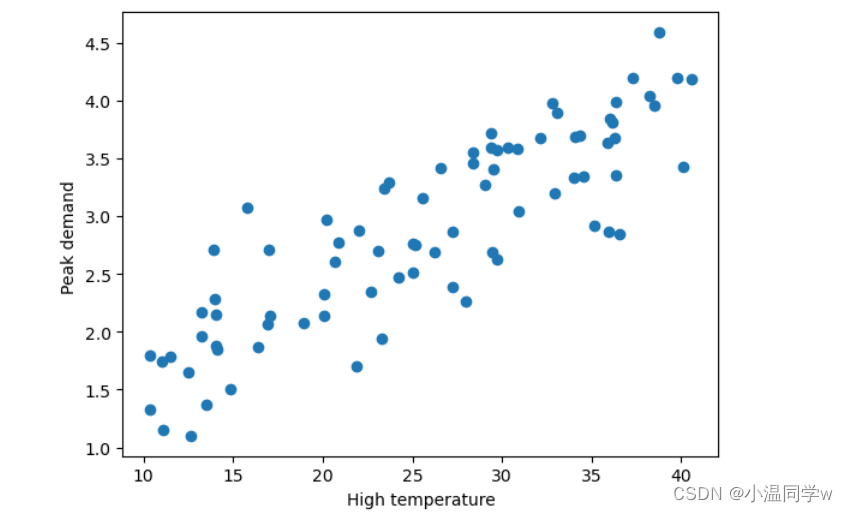


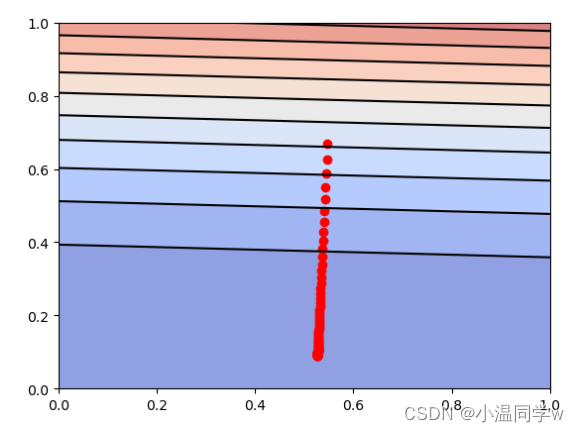
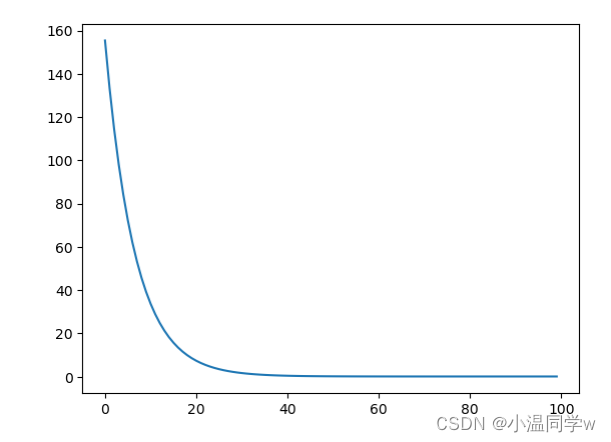


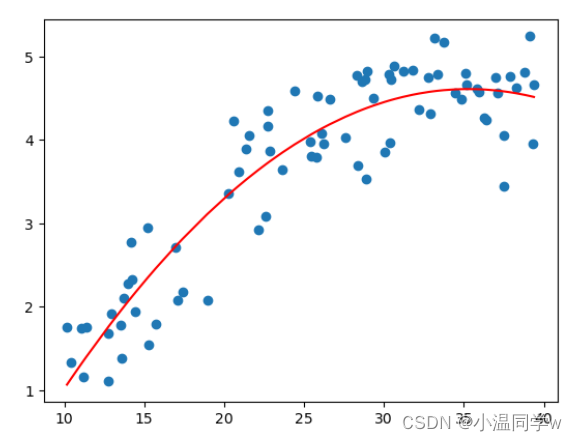
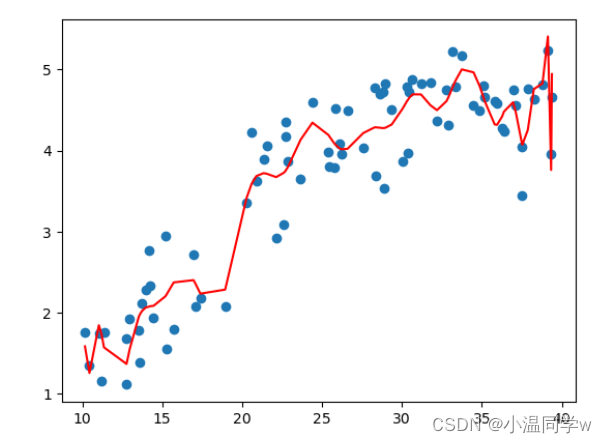














 969
969











 被折叠的 条评论
为什么被折叠?
被折叠的 条评论
为什么被折叠?








